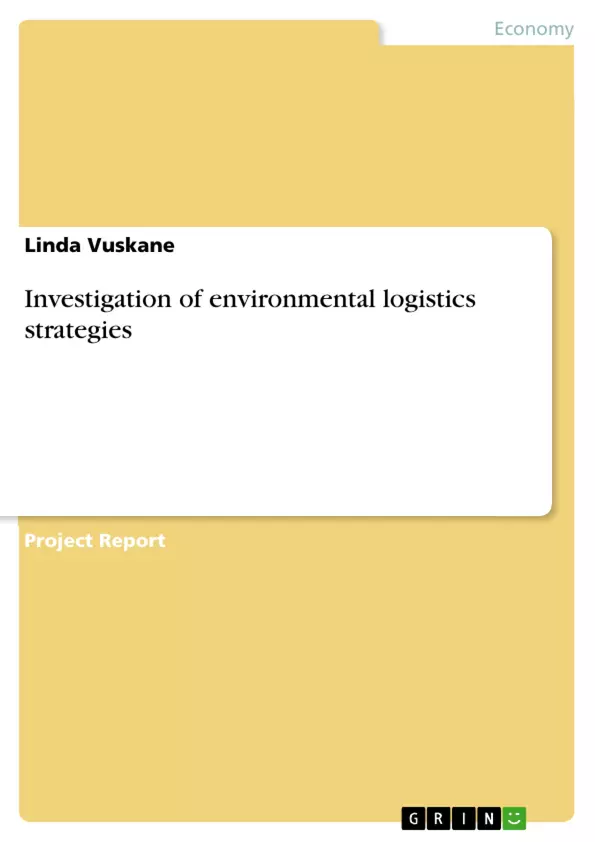The following report investigates the environmental strategies within the logistics field. It provides an overview of the proposed green logistics strategies and insights regarding currently adopted environmental logistics strategies in the UK.
In order to achieve this, a broad literature review was carried, using wide variety of primary and secondary sources. Further an online survey questionnaire was sent to a large sample of companies within the UK, including manufacturing firms and Third Party Logistics Providers of all sizes. In order to reinforce results from primary research, secondary data, including three previously conducted surveys will be consulted.
Report provides an overview of a wide range of proposed environmental strategies. The research revealed that the environmental performance of the logistics sector is developing; however, it is still in its early stages as there are still great potentials to be explored. It was further revealed that the environmental performance of large companies is superior to the smaller companies. While this was expected, it should be noted that on average manufacturing and 3PL companies of all sizes considered environmental issues as currently important and increasingly important in the future. No differences were revealed between manufacturing companies and 3PL providers, with an exception of the institutionalization of environmental measures. The level of adoption of environmental policies and environmental management systems (EMS) among the 3PL companies were extremely low.
The main issues associated with environment were considered energy and materials conservation and waste disposal. Accordingly, strategies most adopted include reduction of energy consumption and material recycling. Secondary research revealed that strategies involving suppliers are also popular.
Results clearly indicated that the compliance with the legislation is the primary reason for implementing green logistics strategies. For small companies more often the reason was demand of the customers. Main problems associated with implementation of green logistics strategies were lack of information and complexity associated with environmental issues.
Inhaltsverzeichnis (Table of Contents)
- LIST OF FIGURES
- LIST OF TABLES
- ABBREVIATIONS
- TERMS OF REFERENCE
- ABSTRACT
- INTRODUCTION
- LITERATURE REVIEW
- INTRODUCTION
- GREEN LOGISTICS STRATEGIES
- Levels of logistics strategies
- Inbound logistics
- Outbound logistics
- Internal logistics
- Transportation strategies
- Modal change
- Improving and redesigning logistical system
- Improving design
- Improving vehicle utilization
- ENVIRONMENTAL MANAGEMENT SYSTEM AND POLICY
- Environmental policy and corporate culture
- ISO 14001 and EMAS
- MOTIVATION FOR GREEN LOGISTICS
- External factors
- Internal motivators
- Levels of motivation
- MAIN PROBLEM AREAS
- Ecological vs. economical factors
- Organizational limitations
- METHODOLOGY
- FINDINGS AND ANALYSIS
- INTRODUCTION
- INFORMATION ABOUT PARTICIPANTS
- Survey questionnaire
- Secondary data
- IMPORTANCE OF ENVIRONMENTAL ISSUES
- Survey questionnaire
- Analysis of secondary data
- ENVIRONMENTAL MANAGEMENT SYSTEM AND POLICY
- Survey questionnaire
- Analysis of secondary data
- IMPLEMENTATION OF ENVIRONMENTAL LOGISTICS STRATEGIES
- Survey questionnaire
- Analysis of secondary data
- REASONS FOR IMPLEMENTING GREEN LOGISTICS STRATEGIES
- Survey questionnaire
- Analysis of secondary data
- MAIN PROBLEM AREAS
- Analysis of secondary data
- CONCLUSIONS
- PROJECT EVALUATION AND SUPERVISION
- REFERENCES
- APPENDICES
- SURVEY QUESTIONNAIRE
- STATISTICAL TESTS PERFORMED FOR THE ANALYSIS OF PRIMARY DATA
- OVERVIEW OF THE SECONDARY DATA
Zielsetzung und Themenschwerpunkte (Objectives and Key Themes)
This report investigates the proposed and currently adopted environmental strategies within the logistics field. It examines further issues related to green logistics, including motivational aspects and problem areas.
- To analyze the current situation regarding environmental performance of logistics activities in the UK.
- To explore the motivation behind the implementation of green logistics strategies.
- To identify key problem areas in the adoption of environmentally friendly logistics practices.
- To examine the impact of company size and field of business on environmental performance.
- To understand the role of environmental management systems and policies in promoting green logistics.
Zusammenfassung der Kapitel (Chapter Summaries)
The report begins with a literature review that establishes the theoretical framework for understanding green logistics strategies. It examines various levels of logistics strategies, including inbound, outbound, internal, and transportation strategies. The review also explores the role of environmental management systems and policies, and discusses key motivators and problem areas associated with implementing green logistics.
The methodology chapter outlines the research approach, including a detailed description of the online survey and analysis of secondary data from three previously conducted surveys. The findings and analysis section presents the results of both primary and secondary data analysis, focusing on the importance of environmental issues, the implementation of environmental management systems, and the adoption of green logistics strategies.
The report concludes by summarizing the main findings, highlighting the key challenges and opportunities in implementing green logistics strategies. It emphasizes the need for a comprehensive approach that considers both economic and environmental factors.
Schlüsselwörter (Keywords)
The main keywords and focus topics of this report include: Green logistics, environmental strategies, logistics performance, motivation, problem areas, environmental management systems, ISO 14001, EMAS, sustainable logistics, supply chain management, transport modal shift, and company size.
- Quote paper
- Linda Vuskane (Author), 2010, Investigation of environmental logistics strategies, Munich, GRIN Verlag, https://www.grin.com/document/156391



